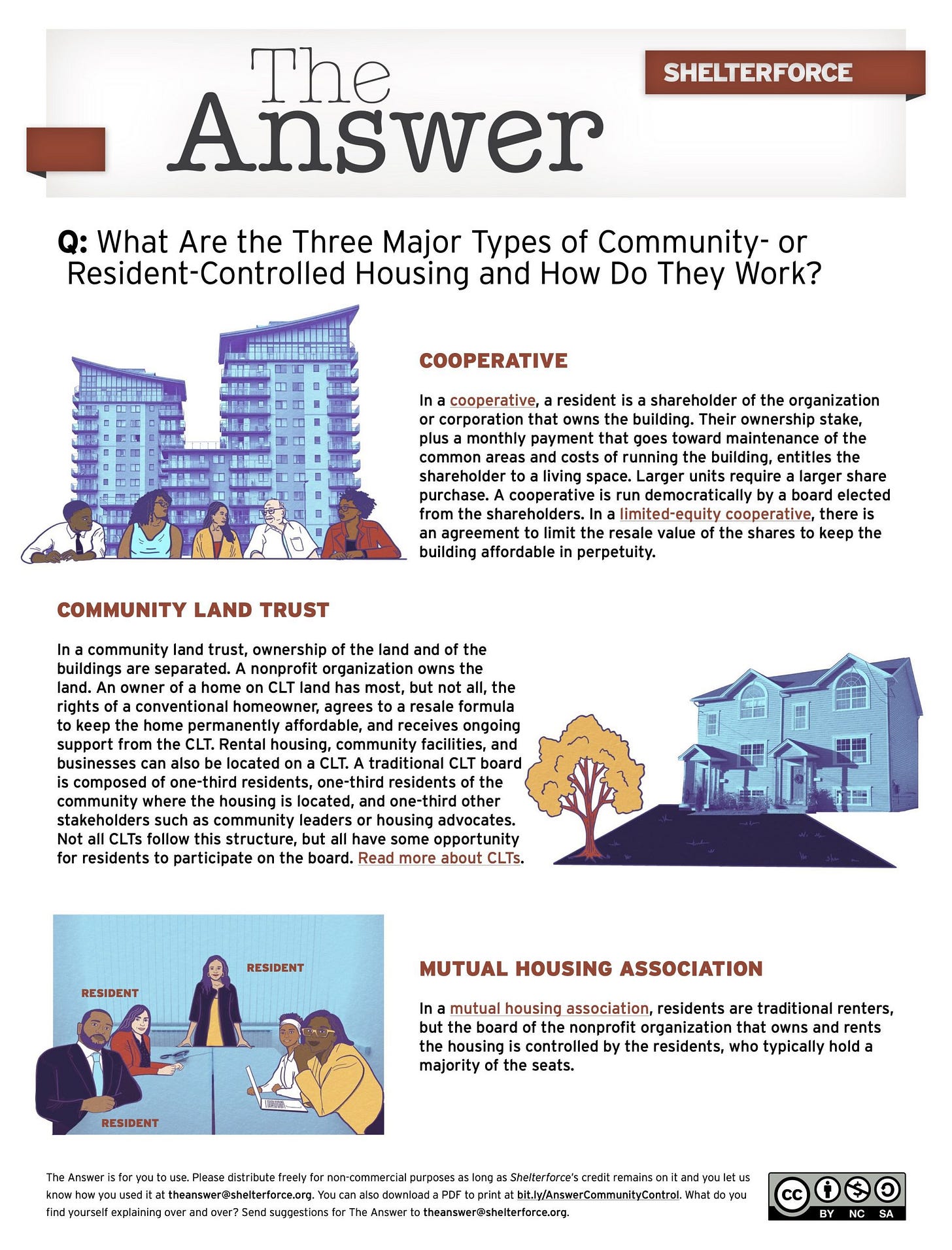Community-controlled housing
There's a lot of possibility out there, we just need to get creative and think expansively.
Refresher: Things never get better because the net impact of a community’s total investment in affordable housing hovers near zero. We lose safe, decent affordable homes at the same rate (or faster) as the amount being added to the market. And the market won’t save us!
But we know that there are some ways to preserve affordability; some are fair and effective, some aren’t. Let’s dive in on those different options later and for now, we’ll just focus on community land trusts. It’s not just the affordability protections that makes the community land trust model worthwhile; it’s also the community power and control embedded into the design.
Let’s look closer, shall we?
In a community land trust, a nonprofit organization owns the land and a private individual owns the house. The individual and the CLT enter a “ground lease”, which governs the relationship. Almost always, the homeowner can use the land exactly the same way as if they own it. You mow the lawn, plant a garden, put up a swingset, whatever. There is a small land lease fee, often included in the escrow payment.
That’s great, but the cool part is what happens when that homeowner sells their house. Because yes, the CLT model expects this to happen and plans for it — unlike some affordability restrictions enforced by certain grants or funders that view an ownership change as failure. Listen, people move for all different reasons. It’s unrealistic and punitive to try to discourage people from making the housing choices that are right for their household.
When the homeowner wants to sell their house, they’ll use the agreed-upon formula outlined in the ground lease to determine how much to sell it for. The seller gets some of the appreciation (say 25%), but the restricted sales price ensures that the house remains affordable for a new buyer.
HERE IS SOMETHING EVEN COOLER ABOUT COMMUNITY LAND TRUSTS: the community controls the land.
In a classic CLT, the board of directors is made up of one-third CLT homeowners, one-third other residents and one-third community representatives. Plus many CLTs are structured as a membership organization, where CLT homeowners and other residents are voting members. This is key! This is cool. This is democratically-controlled ownership. Resident leadership, resident autonomy, resident control. The people behind CLTs know that the market won’t save us, so they remove remove property from the speculative market. Housing bubbles and inflation and buyers markets and sellers markets? Nope. Not when the land is held in a trust controlled by the community.
Shelterforce, an excellent source of housing journalism, published a helpful guide to three types of community-controlled housing: cooperatives, community land trusts and mutual housing associations. The possibilities are rich for how to creatively weave these models together to protect affordability, prevent displacement and build futures that are community-led and resident-driven.
CLTs have their roots in the civil rights movement, where this model was pioneered to prevent the displacement of Black sharecroppers in the rural South. From the outset, the CLT model was less concerned with permanent affordability mechanisms and more focused on retaining community control of community assets.
CLTs can expand past housing too — many CLTs also hold land for commercial space, parks, playgrounds and other neighborhood amenities. Dudley Street Neighborhood Initiative in Boston has a mix of everything in its portfolio, and residents continue to drive development through a formal review process. The pioneering Champlain Housing Trust is similar in this way.
Before the developers come at me, yes I absolutely know that public input can be maddening. In fact, this is one space where the tyranny of homeownership can turn current property-holding residents into an elevated class of citizens with greater rights than their leaseholding neighbors and, more importantly, any future neighbors that might want to move in. Jerusalem Demsas wrote a whole article about it.
But that’s not what we’re talking about here, not really. We’re not even talking about community benefits agreements, which I love, but which can stymie good development if they aren’t thoughtfully considered and crafted.
CLTs can protect communities from extraction and exploitation, while also stimulating investment and growth. It can be beautiful.
We’re talking about residents — members of a CLT — who have made a commitment to further the community good. They’ve agreed to limit their own home’s resale price so that it can be affordable to the next buyer. They understand their home to be not just an individual asset, but a community asset. Or maybe they’ve demonstrated their commitment in some other tangible way. CLTs can protect communities from extraction and exploitation, while also stimulating investment and growth. It can be beautiful.
I’m fascinated by housing alternatives, and by the possibilities we might realize by reconfiguring the rights and responsibilities of homeownership.

We need lots of options in our housing continuum, and we need to stop thinking about it as a linear progression with single-family fee simple homeownership being the end goal for everyone. We just need to get creative and think expansively.








Great resource, thank you! One of our city councilors has been talking with me about a community land trust. I'll pass this on to her!
I’m glad that you called out the grant affordability restrictions that are becoming increasingly onerous and unfair. Preach!